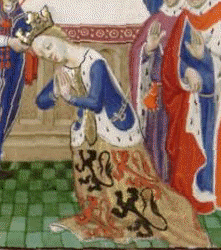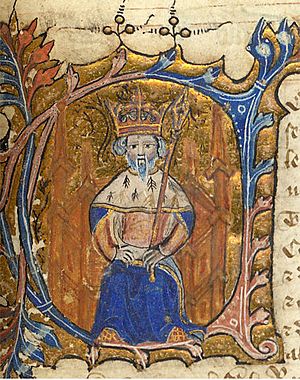Alice Perrers facts for kids
Quick facts for kids
Alice Perrers
|
|
|---|---|

Painting by Ford Madox Brown
|
|
| Born |
Alice Salisbury(?)
Alice Perrers of Holt (?) circa 1348 |
| Died | 1400/1401 |
| Resting place | Church of St Laurence, Upminster, England |
| Other names | Alice de Windsor |
| Known for | Mistress of Edward III of England |
| Spouse(s) | Janyn Perrers (m. 1360; his death in 1364) Sir William de Windsor (m. 1375; his death in 1389) |
| Partner(s) | King Edward III of England |
| Children | 3 including Sir John de Southeray |
Alice Perrers, also known as Alice de Windsor (born around 1348 – died 1400/1401), was a very influential woman in England. She became a close companion to King Edward III of England. Because of the King's support, she became one of the wealthiest and most powerful women in the country. However, many people disliked her and thought she was taking advantage of the aging king.
Contents
Alice Perrers: A Powerful Woman in Medieval England
Her Early Life
Alice Perrers was born around the year 1348. We don't have her exact birth record. It seems that "Perrers" was the last name of her first husband. Around 1360, when she was about 12 years old, she married Janyn Perrers, who was a jeweler. He passed away around 1364.
Life at the Royal Court
Alice Perrers joined the royal household of Queen Philippa before 1359. She worked as a "damsel," which was a lady-in-waiting. Around 1366, when Alice was about 18, she became a close companion to King Edward III. The King was 55 years old at that time.
Alice and the King had three children together while Queen Philippa was still alive. The Queen died three years after Alice and the King became close. This made the King very sad, and he relied on Alice even more. This also meant that Alice received a lot of attention from the royal court, much of it negative.
The King gave Alice many gifts, which quickly made her extremely rich. She gathered a fortune worth more than £20,000. This would be like having about £6,000,000 today! The King even had her ride through London in golden clothes. She was called the "Lady of the Sun." This caused a lot of public criticism.
Alice's power grew even more between 1370 and 1376. People were reportedly afraid of her, and no one dared to challenge her in court. She was seen as a very ambitious person who used her influence over the elderly King. Towards the end of King Edward III's life, some even accused Alice of making his life difficult.
As the King's health was failing, Alice secretly married Sir William de Windsor in November 1375. She was 27, and he was 53. This marriage was to make sure she would be safe and have money after the King died. Sir William was the King's representative in Ireland. He spent a lot of time away from England, so it was less likely the King would find out about their marriage. They stayed together until Sir William died in 1384, but they did not have any children.
Her Exile
In 1376, a special rule was made that targeted Alice Perrers. This rule set punishments for women who interfered with legal processes. It said that no woman should do this, especially Alice Perrers. If she did, she would lose her property and be sent away from England.
Alice was accused of using her influence unfairly and was then sent away from England by the Good Parliament. Her lands were taken away. However, she was later able to return to England and get some of her lands back.
Later Life and Death
Alice Perrers passed away during the winter of 1400 or 1401. She was around 52 years old. She was buried at the Church of St Laurence in Upminster, England.
Her Wealth and Lands
When Alice Perrers was at the peak of her power, she owned many properties. She had 56 large houses and town houses in over 25 different areas of England. Only 15 of these were gifts from the King. Her properties included Playford Hall in Suffolk and the manor of Gaynes in Upminster, Essex.
Influence on Writers
Some historians believe that Alice Perrers might have inspired characters in famous old stories. She is thought to be the model for the "Wife of Bath" in The Canterbury Tales by Geoffrey Chaucer. She also supported Chaucer's work. Her influence might also be seen in the character of Lady Mede in Piers Plowman by William Langland.
Her Children
Alice Perrers had three children with King Edward III. These children were born between 1366 and 1369, while Queen Philippa was still alive.
- Sir John de Southeray (born around 1364 – died 1383). He married Maud Percy, but they did not have children.
- Jane (born around 1365). She married Richard Northland.
- Joan (born around 1366 – died before January 1431). She married Robert Skerne, who was a lawyer and a member of parliament.
Alice did not have any children from her marriage to William de Windsor.
Alice in Stories
Alice Perrers appears as a character in many historical novels.
- She is featured in Candace Robb's Medieval Mysteries series.
- She is the main character in Robb's The King's Mistress, written as Emma Campion.
- She appears in Anya Seton's 1954 novel Katherine.
- Alice Perrers is the main character in Vanora Bennett's 2010 novel The People's Queen.
- She is a character in Jean Plaidy's Vow on the Heron.
- She is portrayed in Rebecca Gablé's Das Lächeln der Fortuna, a German historical novel.
- She is the main character of the 2012 novel The King's Concubine by Anne O'Brien.
- She also appears in The Traitor's Noose, the fourth novel in the Lions and Lilies series by Catherine A. Wilson and Catherine T. Wilson.




